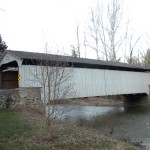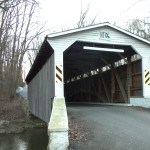Elk Township was formed in 1857 from 10.4 square miles that were formerly part of East Nottingham. Besides being the smallest township geographically in the area, it also is the least populated. As part of the historical “Nottingham Lots,” its settlement dates to a grant from William Penn in 1701.
In 1763 Charles Mason and Jeremiah Dixon began a survey for the Royal Society to establish the boundaries of the lands of the Penn family and those of the Calverts. The survey, which delineated the border between Pennsylvania and Maryland and the southern boundary of Elk Township, was completed in 1769.
It is not surprising that this township is dotted with mills, since it is bordered on the east by the Big Elk Creek, with branches of the Little Elk Creek winding through the area.
A part of the Serpentine Barrens is also included in the township, and gives its name to the Barren branch of the Little Elk Creek and Barren Road.
The township boasts three covered bridges: the Linton Stephens, named for a postmaster at Hickory Hill; The Rudolph and Arthur Bridge, an 80-foot bridge built in 1880 by Richard T. Meredith and named for a mill along the stream; and the Glen Hope Bridge, which crosses the Elk Creek just north of the Maryland border.
- Rudolph Arthur Covered Bridge “Between 1850 and 1909 a large dam above the bridge site supplied power for a paper mill. Three generations of the Rudolph family were active in the paper mill operations. When the bridge was built in 1880, Charles Arthur was a member of the paper firm that operated under the name of Rudolph and Arthur,” writes Arthur E. James, author of Covered Bridges of Chester County.
- Glen Hope Covered Bridge The Glen Hope Bridge is 65-feet in length and was built in 1889 by Menander Wood and George E. Jones with a Burr-like arch truss. The bridge was burned by vandals in the late 1980s and was restored by 1994.
- Linton Stevens Covered Bridge The Linton Stephens Bridge is in the northernmost of the township, bordering on New London Township. This bridge was built in 1886, also with a Burr truss, by J. Denithorne and Son. It is 102-feet in length, and while a car may cross it, the road beyond is open to vehicles with permits only.
The Villages
Elk Mills
Located along Elk Mills Road about where Rogers Road comes into it, the village of Elk Mills was a center of business activity during much of the eighteenth and nineteenth centuries. Besides being the site of a succession of mills, Elk Mills was also the location of a store and a post offices.
Tradition says Henry Hollingsworth had a mill on the Little Elk in 1724, perhaps the first mill in the area. A later mill was purchased in 1880 by Lewis Sharpless, who believed it had been in operation for more than a century. This mill, a combination saw- and grist-mill, had been owned previously by James Brown and before that by Jesse Woolens.
When a post office was established in Elk Mills on October 22, 1869, James Brown was appointed postmaster, and may have operated out of his mill. Lewis Sharpless served as postmaster from 1882 until 1909, when the Elk Mills post office was closed.
Mount Rocky

Samuel Ankrim Shop — This small, attractive building was erected about 1790, has been used through the years as the shop of a spinning-wheel maker, a turner, a shoemaker, and others. Ned Goode, Photographer May 1959.
Located in a part of the Barrens, Mount Rocky was named when George Churchman gave a patent to Elisha Gatchell for 45 1/2 acres of Lot #13 of the Nottingham Lots. It was in this vicinity that the Mount Rocky Methodist Church was built of squared logs in the early part of the nineteenth century.
Hickory Hill
In and around the area known as Hickory Hill were grist- and sawmills, a limekiln, and the Little Elk Friends Meeting, established in 1825. The village was called Nottinghamdale until the establishment of a post office in 1850 when the name was changed to Hickory Hill.
Lewisville
Lewsiville grew up at the junction of at the junction of several roads. In this instance, Route 472 ends (or begins) in this community, as does Route 841. The road from Strickersville also comes into this village, making a hub, which no doubt accounts for the fact that the Lewisville post office was one of the early ones, having been established in 1848. James McDowell was the first postmaster. The present home of the Lewisville post office was opened December 8, 1975.
Excerpted from Around the Oak, Oxford Area Tricentennial and County Fair Committee and Tricentennial Publications Committee, 1982




